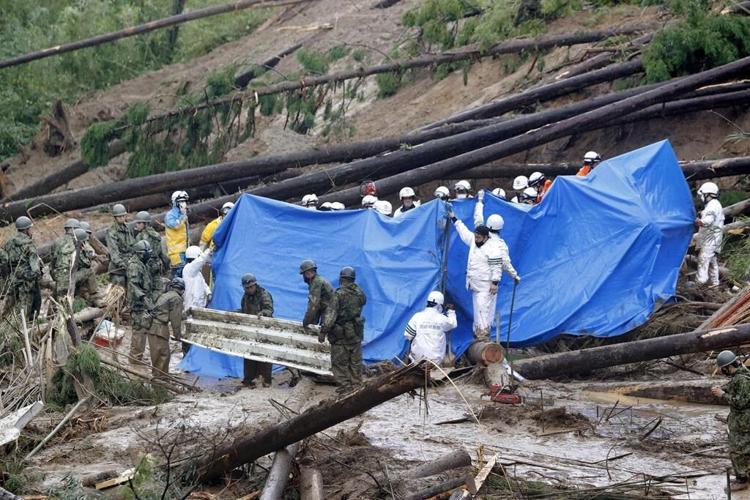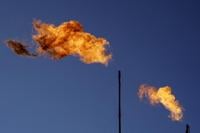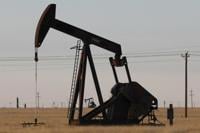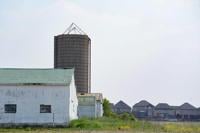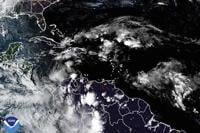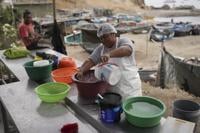TOKYO (AP) — Temperatures are rising in Japan and summer is coming fast.
Cherry blossoms than ever before, chiffon-pink that’s traditionally heralded spring for the nation popping up just two weeks into March.
In Osaka, temperatures soared to 25 degrees Celsius (77 degrees Fahrenheit) on March 22, a record for that time of year. Tottori, in the southwest, hit 25.8 C (78 F) on the same day, the highest in 140 years, according to climatologist Maximiliano Herrera. Tottori’s temperatures usually hover around 12 C (54 F) in March.
With thermometers already shooting upward and around the world, Japan is set for another sweltering summer and is at growing risk of flooding and landslides. The nation is scrambling to protect communities from warming and has pledged to slash emissions, but in the short term the worsening weather remains a threat.
“The risks from climate change are right before us,” said Yasuaki Hijioka, deputy director of the Center for Climate Change Adaptation at the ���ϳԹ��� Institute for Environmental Studies in Tsukuba, northeast of Tokyo.
“You can in principle try escaping from a flood. But heat affects such a wide area, there is almost no escape. Everyone is affected.”
Japan is already prone to natural disasters like earthquakes, tsunamis and typhoons. Secure infrastructure has kept people safe for the most part. But climate change means communities are often caught off guard because the systems were engineered for the weather conditions of the past.
“If you’re pushing the electrical grid that was designed for the 20th century into a new century of warming and heat extremes, then you are going to have to consider whether your energy system and your health care system are really designed for a warming planet,” said Kim Cobb, director of The Institute at Brown for Environment and Society.
More people are getting sick because of heat stroke.
, more than 200 temperature records were broken in cities across the nation, sending energy grid to near-capacity and over 71,000 people to hospital for heatstroke through the months of May to September. Patients were mostly elderly but a fair number of children and middle-aged adults were also hospitalized, according to government figures. Eighty people died.
The warming weather can also hold more moisture, adding flooding and landslides to the summer forecast, something that Japan .
In 2019, bullet trains were partially submerged in flooding from Typhoon Hagibis. Homes and highways were caught in landslides. Flooded tunnels trapped people and cars. Dams couldn't withstand the surprisingly heavy rainfall.
Hijioka’s research is focused on flood management, such as diverting water from swelling rivers upstream into rice paddies and ponds to drain to avert flooding.
To prevent deaths from heatstroke, a proposed law would designate certain buildings in communities, such as air-conditioned libraries, as shelters. That kind of law on the national level is new in Japan.
Despite the country's advanced economy, some people cannot afford air conditioning, especially in areas not accustomed to the heat. Schools in northern Japan, such as in Nagano, have installed air conditioning because of the extreme heat in recent years.
"More people have been dying from heatstroke than from river flooding in Japan,” said Hijioka. “We need to view climate change as a natural disaster.”
Michio Kawamiya, director of the Research Center for Environmental Modeling and Application, and his team research Japan’s higher temperatures and how they affect people.
Among their findings: Since 1953, cherry blossoms have bloomed on average one day sooner every decade. Maple leaves have changed color 2.8 days slower per decade. The risk of typhoons has gone up and the amount of snowfall has declined, even as the threat of heavy snowfall remains.
Japan has made some headway in curbing the amount of fossil fuels it spews, but it's still the world's sixth-highest emitter. After the the country shut down nuclear generation, and, fatefully for the climate, invested in new coal plants as well as imported oil and gas to keep its grid running. Nuclear plants have gradually restarted since then.
On the positive side, its excellent has kept gas-guzzling cars off roads, lowering the country's carbon footprint. Some Japanese people have been turning their air conditioning off to save energy, but that has health implications, as it comes precisely at a time when heat has been reaching dangerously high levels.
The country has already worked so hard to conserve energy by reducing demand that doing more has often been compared to “wringing water out of a totally dry rag,” Kawamiya said in an interview at his office in Yokohama, southwest of Tokyo.
Still, critics say Japan could be doing more to boost renewable energy use, such as solar and wind power. The government plans for renewables to by 2030 and to sometime in the 2040s.
Japan is also part of the Group of Seven leading economies that pledged to be by 2035.
Since Fukushima, Japan has kept most of the nation’s 50-some nuclear reactors offline, in response to public opinion that’s turned against the technology. Nuclear power is considered a clean energy as it doesn’t emit greenhouse gases, but it does produce radioactive waste.
About 10 reactors are up and running, 24 reactors are being decommissioned. What Japan will eventually decide on nuclear power .
Hijioka, who believes Japan lags in the shift toward renewable energy, said he was frustrated by policymakers who he said have dragged their feet on dealing with climate change, but are pushing a return to nuclear.
Despite its potential to curb planet-warming emissions, skepticism remains among some climate experts about turning to nuclear power due to costs and timescales of projects compared to how quickly and cheaply an equivalent amount of renewable energy can come online. There are also concerns among the public.
“It’s utterly irresponsible, when we think about the next generation," Hijioka said. "We may be old, and we may die so it might not matter. But what about our children?”
___
Yuri Kageyama is on Twitter
___
Associated Press climate and environmental coverage receives support from several private foundations. See more about AP’s climate initiative . The AP is solely responsible for all content.



